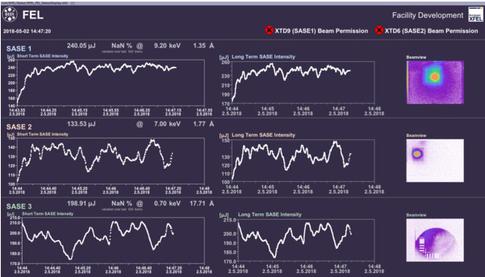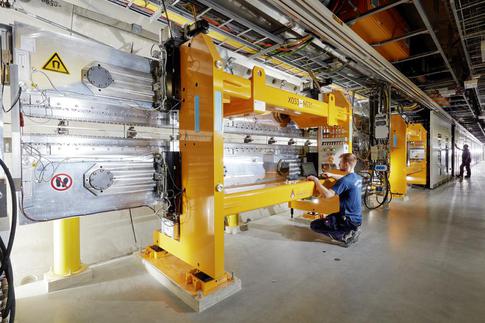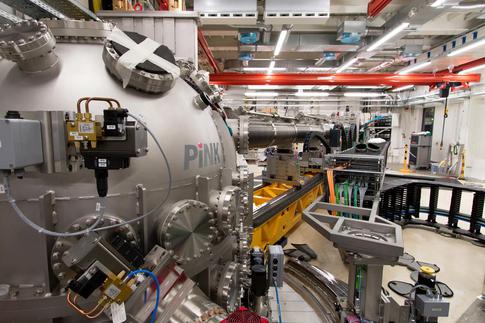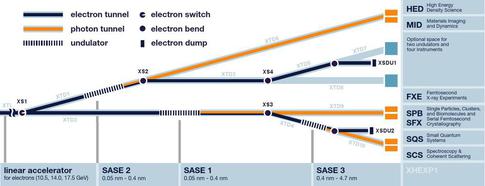XFEL: Third light source generates first X-ray light
Third light source generates first X-ray light

European XFEL starts operation of its third light source, exactly a year after the first X-ray light was generated in the European XFEL tunnels. The third light source will provide light for the MID (Materials Imaging and Dynamics) and HED (High Energy Density Science) instruments scheduled to start user operation in 2019. All three light sources, successfully run in parallel for the first time on the anniversary of European XFEL’s first light, will eventually provide X-rays for at least six instruments. At any one time, three of these six instruments can simultaneously receive X-ray beam for experiments. “The operation of the third light source, and the generation of light from all sources in parallel, are important steps towards our goal of achieving user operation on all six instruments” said European XFEL Managing Director Robert Feidenhans’l. “I congratulate and thank all those involved in this significant accomplishment. It was a tremendous achievement to get all three light sources to generate light within the space of one year.”

Undulators in the European XFEL tunnels. Copyright European XFEL
To generate flashes of X-ray light, electrons are first accelerated to near the speed of light before they are moved through long rows of magnets called undulators. The alternating magnetic fields of these magnets force the electrons on a slalom course, causing the electrons to emit light at each turn. Over the length of the undulator, the produced light interacts back on the electron bunch, thereby producing a particularly intense light. This light accumulates into intensive X-ray flashes. This process is known as ‘self-amplified spontaneous emission’, or SASE. European XFEL has three SASE light sources. The first one, SASE 1, taken into operation at the beginning of May 2017, provides intense X-ray light to the instruments SPB/SFX (Single Particles, Clusters and Biomolecules and Serial Femtosecond Crystallography) and FXE (Femtosecond X-ray Experiments), the first instruments available for experiments and operational since September 2017. The second light source, SASE 3, was successfully taken into operation in February 2018 and will provide light for the instruments SQS (Small Quantum Systems) and SCS (Spectroscopy and Coherent Scattering), scheduled to start user operation in November 2018. SASE 1 and SASE 3 can be run simultaneously – high speed electrons first generate X-ray light in SASE 1, before being used a second time to produce X-ray light of a longer wavelength in SASE 3. Now, exactly a year after the first laser light was generated in the European XFEL tunnels, the third light source, SASE 2, is operational. SASE 2 will generate X-ray light for the MID (Materials Imaging and Dynamics) and HED (High Energy Density Science) instruments scheduled to start user operation in 2019. The MID instrument will be used to, for example, understand how glass forms on an atomic level, and for the study of cells and viruses with a range of imaging techniques. The HED instrument will enable the investigation of matter under extreme conditions such as that inside exoplanets, and to investigate how solids react in high magnetic fields.

The MID instrument at European XFEL, currently under construction. Copyright: European XFEL
DESY and European XFEL staff and scientists have worked hard over the last year to ensure the timely start of operation of all three light sources, and have also continually improved the parameters of the X-ray beam and instruments. Since the first users arrived in September 2017, the number of X-ray pulses available for experiments has been increased from 300 to 3000 per second for the next experiments, scheduled from August to October 2018. At full capacity, the European XFEL is expected to produce 27,000 pulses per second and DESY and European XFEL teams are working towards achieving this rate in test conditions during the next few months. In addition, the construction and commissioning of the remaining four instruments continues this year. Once MID and HED start operation in 2019, European XFEL will have a total of six experiment stations available for users, running from the three light sources.

Graphic showing the layout of the European XFEL tunnels, three SASE undulators and the instruments. Copyright: European XFEL
Since the start of user operation in September 2017, European XFEL has hosted over 500 researchers in international and interdisciplinary teams for experiments on the first two instruments. SPB/SFX and FXE share the X-ray beam generated in SASE1, each using the beam for alternate 12 hours per day during an experiment. Each user group generally has five days of beamtime. For the next round of experiments due to start in August, 61 proposals were received from which twelve experiments, six per instrument (SPB/SFX and FXE), will be granted.
A next call for user proposals for experiment time, now at all six instruments, will open shortly.
